from the

Walking the Straight and Narrow with Chris Hillman
By Jon Kanis, October 2015
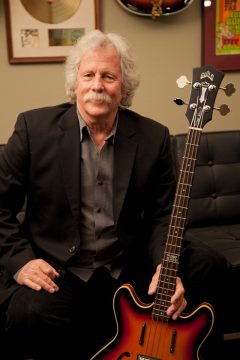
As risk takers who dance on the perimeter between the known and the unknown, pioneers are heroic explorers who perform a cosmic function. It’s even more incredible when a musician is able to rise above the overwhelming odds of Early Mortality Syndrome, and live long enough to witness their body of work become a cultural institution.
Chris Hillman is one of those rare artists. He’s as deserving as any other American musician of the 1960s and ’70s to have his face chiseled upon the Mount Rushmore of cultural achievement. As a founding member of the Byrds; the Flying Burrito Brothers; Manassas; McGuinn, Clark & Hillman; and the Desert Rose Band, Hillman has explored every corner of American music: country, bluegrass, folk, rock ‘n’ roll, psychedelia, pop, and the blues. And he’s even managed to create a musical hybrid or two along the way (i.e., folk rock and country rock/outlaw country).
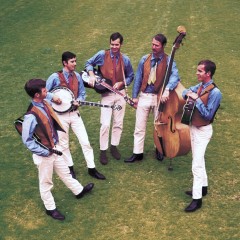
Born on December 4, 1944, in Los Angeles, California, Hillman was the third of four children, spending his formative years in the Rancho Santa Fe area of San Diego’s North County. He remembers it being “tiny, with a population of about 700 people; it was mostly agriculture. It wasn’t until I was in the Scottsville Squirrel Barkers [1963–64] bluegrass band that I lived in San Diego proper. And, believe it or not, in 1976 I lived in Birdrock, right on the border of La Jolla and Pacific Beach—it’s the poor part of La Jolla!” he says, laughing. “But I really am from San Diego, that’s where I grew up.”
Hillman’s mother bought him his first guitar when he was 14, and it wasn’t long before he was obsessing about the mandolin, after seeing the Kentucky Colonels perform. Hillman was so passionate about the instrument that he talked his mother into letting him take mandolin lessons (traveling all the way to Berkeley no less!) from the Colonels’ Scott Hambly. After a two-year stint with the Scottsville Squirrel Barkers, Hillman became so adept at guitar and mandolin that he was asked to join the Golden State Boys. Producer/engineer/manager Jim Dickson liked the group so much that he made one professional recording of them right as they morphed into the Hillmen. And then, on February 9, 1964, everything changed.
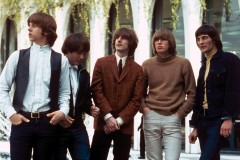
“I worked for the Golden State Boys for six to eight months, when in February 1964, the Beatles hit big,” says Hillman. “They played the Ed Sullivan Show and just took off. That one performance of the Beatles just affected so many young musicians, myself included, and within a short period of time I got the job offer to join the Byrds.”
The invitation came from Dickson, who was working at World Pacific Studios in Los Angeles with three acoustic guitarist/vocalists: Gene Clark, David Crosby, and Roger McGuinn. The trio was singing Beatles songs together and working on their original compositions. With drummer Michael Clarke already in the fold, Hillman was recruited to play electric bass, even though he had never touched the instrument before.
“That’s right,” says Hillman. “I had never played bass before and I went in there and sweated bullets at that first rehearsal. I didn’t know the other guys too well. I knew them, but I didn’t know them. I assumed they were rock ‘n’ roll players, but they weren’t. They were guys who were into folk music. Everybody plugged in and we all learned how to play. So that was a good thing. The thing that made the Byrds unique was that we didn’t know how to play rock ‘n’ roll. We really just took what we did know, which was acoustic folk music, and amplified it. I was really lucky to have been in that band.”
In show business it’s not what you know, but whom you know, and Dickson happened to be friends with Bob Dylan, who in late 1964 had written a remarkable song called “Mr. Tambourine Man.” After initial talks with Elektra Records came to naught, the group signed to Dylan’s label, Columbia Records. With the bard’s blessing, a truncated version of “Mr. Tambourine Man” was recorded by the Byrds, where it landed at the #1 spot on the Billboard Hot 100 in June of 1965.
“I call Jim Dickson the architect of the Byrds,” says Hillman. “He was our Brian Epstein, the one who brought us our first hit single. And he told all of us to ‘make records that you’ll be proud of in 40 years.’ That’s the greatest advice I ever received in my life. ‘Go for depth, and go for substance in the lyric.’ And we learned to write better songs that way, too. Using that as a measuring stick.”
Five months after “Mr. Tambourine Man,” the Byrds scored their second (and last) #1 hit, with a number borrowed by Pete Seeger from the Book of Ecclesiastes: “Turn! Turn! Turn! (to Everything There Is a Season).” But by 1966, the times they were a-changing rapidly within the Byrds’ ranks. On their first two LPs, the group had relied on a clutch of Bob Dylan covers, a few traditional folk tunes, and an impressive portfolio of Gene Clark compositions that were as strong as anything the band recorded. However, when Clark left the group after creating the groundbreaking psychedelic single “Eight Miles High” (co-written with McGuinn and Crosby), a songwriting void formed in the group. Incredibly, McGuinn, Crosby, and Hillman rose to the challenge by providing first-rate material for their next two albums: 1967’s Younger Than Yesterday, and 1968’s The Notorious Byrd Brothers.
It is rather mind-blowing how fully formed Hillman’s songwriting and singing became, particularly as he had done neither up through the Byrds’ third album Fifth Dimension. “I was not a good singer, the first 10-15 years, but I absorbed a lot,” says Hillman. “My voice was pleasant; I could sing in tune, but it didn’t have any feeling to it. But I had the best teachers around me: I had David Crosby, I had Roger McGuinn, and Gene Clark; I had Stephen Stills when I was working in Manassas, and Gram Parsons – all great singers.
“But I remember the first song I wrote was “Time Between” on the Younger Than Yesterday album. I had a week or two of getting all of these ideas, and it worked out really well. “So You Want to Be a Rock ‘n’ Roll Star” is one of my favorite Byrds tracks. A lot of that is Roger writing with me, he wrote the bridge. ‘And in a week or two when you make the charts, the girls will tear you apart.’ And the riff we got from the session with trumpeter Hugh Masekela.” The mind-bending Younger Than Yesterday also includes the classic Hillman songs “Have You Seen Her Face,” “Thoughts and Words,” and “The Girl with No Name.”
Hillman was clearly on a roll and his writing would hit a major stride on the next LP, The Notorous Byrd Brothers, where he wrote (or co-wrote) seven of the 11 tracks. It was an artistic triumph, and possibly the Byrds finest hour, in spite of the fact that Crosby and drummer Michael Clarke had both left the group by the end of the sessions, leaving McGuinn and Hillman to finish the album by themselves (all of the juicy details are in Johnny Rogan’s seminal book Timeless Flight: The Definitive Biography of the Byrds).
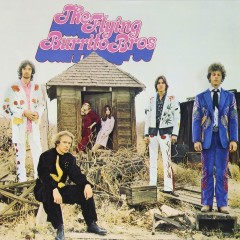
Enter Gram Parsons and the traditional country-styled reinvention of the Byrds in 1968 with their sixth LP Sweetheart of the Rodeo. And just as quickly as he would enter the picture, Parsons flew the coop, but not before seducing Hillman into leaving McGuinn in order to perform what they dubbed “Cosmic American Music” in an outfit called the Flying Burrito Brothers. Two superb LPs resulted from the collaboration: The Gilded Palace of Sin and Burrito Deluxe. But Parsons’ wanderlust got the better of him, and he departed for a short-lived solo career at Reprise Records – as he was destined to perish at the Joshua Tree Inn in September 1973 before his second solo LP (Grievous Angel) was released. Two months earlier, a drunk driver had killed Byrds’ guitarist Clarence White while loading out after a performance. It was a dark period.
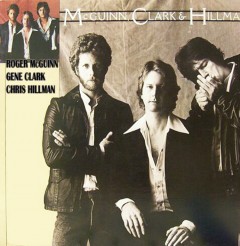
But Hillman persevered and, despite the setbacks, had a sprawlingly productive time throughout the ’70s, even if the diverse array of projects weren’t destined to last any longer than it takes to dance a two-step. The Burritos continued with a pre-Firefall Rick Roberts replacing Parsons, producing two more LPs (The Flying Burrito Brothers and Last of the Red Hot Burritos) until Hillman was propositioned by Stephen Stills to form the seven-piece ensemble Manassas. After releasing two solid LPs (Manassas and Down the Road), the group went their separate ways, opening the door for Hillman to reunite with all five original Byrds in 1973, for a one-off, self-titled LP produced by David Crosby. That reunion was short-lived, and Hillman soon joined ranks with J.D. Souther and Richie Furay for two LPs, as the Souther-Hillman-Furay Band. Two solo LPs came and went between 1976 (Slippin’ Away) and ’77 (Clear Sailin’). By 1979 Hillman reunited once again with Roger McGuinn and Gene Clark for two LPs as McGuinn, Clark & Hillman, and a third LP with just McGuinn (McGuinn/Hillman), before recording Desert Rose in 1984 and Ever Call Ready in 1985.
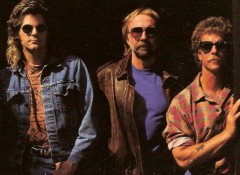
The 1980s and ‘90s saw another peak in Hillman’s visibility when he co-founded the Desert Rose Band, a dynamic country/western group who recorded seven albums in six years, collecting 16 top ten country hits, and a slew of awards along the way.
But after 30 straight years of a life on the road and in the studio, it must have become a grind, because in 1994 Hillman decided to quit touring in order to spend more time at home with his wife and two children. Hillman jokingly remarked that the name of his memoirs ought to be If I See Another Hotel Room, I’m Going to Scream.
Which brings us to the present day, and Hillman’s 20-year partnership with his collaborator Herb Pedersen. Their last recording from 2010, At Edwards Barn, is a fair approximation of what you’re going to hear when the duo comes to town this month at Acoustic Music San Diego.
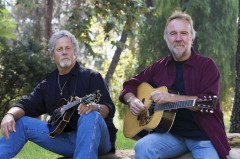
But at 70 years of age, Hillman feels that his time as a performer is starting to wind down. “I’m certainly not chasing a career, I’ll put it that way,” he says without a trace of irony. “I have some new songs, with enough material to make an album, but would I be making it for vanity? Is this the last hurrah? Maybe. And seeing as how the whole situation has changed; I got into the music business at a very great time in the early ’60s, when they were making vinyl records, and there were retail outlets where you could buy them. It’s not like today, where your shelf life is maybe a year. My son says if I’m going to do another album I should just go in and cut it live. Turn on the machine, and just cut it with people that I like, and do it live. That’s a good idea, just go for the edginess of it, and don’t make some paint-by-numbers record. I might cut a song that McGuinn and I wrote called “Here She Comes Again.” It’s a cool song, very Byrds-like. It could have been on our first or second album.
“Believe it or not, what I listen to now is stuff that my parents listened to: Nat ‘King’ Cole or Ella Fitzgerald. I listen to them and think ‘Oh my God, what great singers.’ Music was so alive in the ’20s, ’30s, and ’40s, and there were such incredible songwriters: Johnny Mercer, Hoagy Carmichel, Cole Porter. And taking nothing away from my generation, but the lyrics and the melodies were so good. I mean, rock ‘n’ roll in the ’50s was great, you know that. And the Beatles were fantastic – you were never going to hear a Beatles song and be sad.
“Music is something that always elevates me in a spiritual sense, and it never ceases to enlighten me. And I love to play, but I’m winding it down to where I only play a little bit every month, if that. And I’m lucky, because it’s all down to if people want to hear you. If no one’s buying tickets to your shows, then you do something else, you put it down for a while.
“But that doesn’t mean people shouldn’t get into music, which leads me to the next thing, because I ALWAYS get this question: ‘Mr. Hillman, do you have any advice for me and my band?’ And to every 19-year-old kid I say ‘I do.’ I say learn how to do something: be an electrician or a plumber. Go to school and get a four-year degree in something you really like, because it’s so tough out there now. But don’t stop playing music.”
“And I’m very happy in my own skin. I’ve been very blessed, very lucky to do what I’ve been doing all these 52 years.”
As a legendary figure of American music, Hillman has much to be proud of career-wise. But it doesn’t hold a candle to the importance he places on his family.
“I love what I’ve done musically,” he says. “But I think that I survived all these years by having a family, and by finding someone that I fell in love with and married 36 years ago, and by having two kids that grew up to be incredible. It’s just a good family,” he says laughing. “What more can I say?”
It sounds like the perfect dénouement for a day in the life of an American icon.
See Chris Hillman and Herb Pedersen on Saturday, October 17, 7:30pm, at AMSD Concerts, Sweetwater Union High School, 2900 Highland Avenue, National City. Jack Tempchin opens.
No comments:
Post a Comment